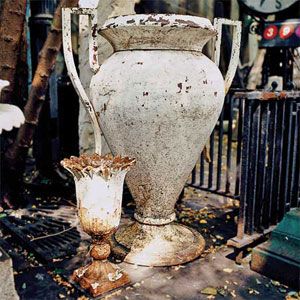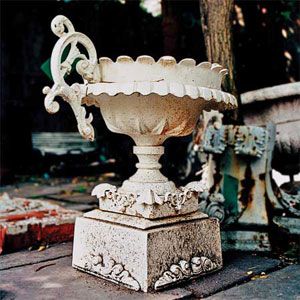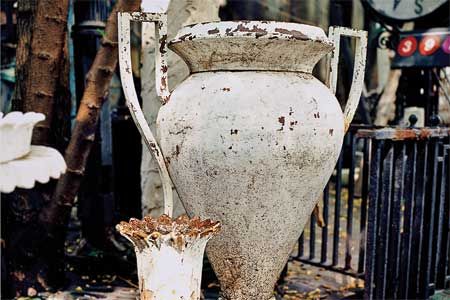Victorian garden urns are decorative containers that give a nod to an era of opulence. They add touches of classical elegance to modern outdoor gardens, and offer a unique blend of form and function. Read the guide below to learn about the rich history behind garden urns, how to incorporate them into your garden, and which materials and motifs might best suit you.
The History and Significance of Victorian Garden Urns
Victorian garden urns emerged as popular landscape features during the second half of the 19th century. They reflect the era’s penchant for elaborate decoration indoors and outside.
Origins in 19th Century Landscaping
The Victorian era, which spanned from 1837 to 1901, saw a dramatic shift in garden design. As the middle class grew, so did the desire to showcase status and cultural refinement through landscaping. Gardens became areas of leisure and display, and ornamental urns became key elements in these new designs thanks to their classic forms and intricate details.
Symbolism of Status and Culture
Garden urns were symbols of wealth and sophistication. Incorporating them into your garden meant that you could afford indulgences. These ornate pieces allowed homeowners to showcase their taste and financial means, which turned gardens into outdoor galleries.
Types of Victorian Garden Urns
Victorian garden urns are available in various styles, and each features its own distinct characteristics and appeal.
Campana-Style Urns

Campana urns are shaped like upside-down bells, and are among the most recognizable Victorian styles of urns. They feature wide, flaring mouths and narrow bases, which are often adorned with intricate patterns or relief work. Their elegant shapes make them ideal for showcasing cascading plants or serving as striking standalone pieces in garden settings.
Tazza-Style Urns

Tazza urns are named after the Italian word for “cup,” and look like shallow, wide bowls. These urns often sit atop pedestals, and create graceful silhouettes that are reminiscent of champagne coupes. Tazza urns can serve as bird baths in gardens or pots for low-growing plants.
Rococo-Inspired Designs
By 1880, urn designs became more fanciful, and incorporated elements from the Rococo style. These urns featured elaborate embellishments such as cherubs, shells, and floral motifs. The ornate nature of these designs made them true statement pieces in Victorian gardens.
Neoclassical Urns
Neoclassical urns are symmetrical, and feature simple and elegant designs. They’re inspired by Greek and Roman art, and include smooth lines, fluted columns, and minimalistic relief work. Their timeless appeal makes them suitable for both traditional and contemporary garden settings.
Materials and Manufacturing for Garden Urns
Choosing the right material and manufacturing techniques determined how long urns could last. Read more below.
Cast Iron: The Preferred Medium
Cast iron emerged as the material of choice for garden urns in the Victorian era. Its durability, malleability, and relatively low cost made it ideal for mass production. Cast iron urns could withstand the elements while maintaining their elaborate designs, which made them a practical and aesthetically pleasing choice for outdoor use.
Terracotta and Stone Urns
Terracotta and stone were also popular materials for Victorian garden urns. Terracotta urns featured earthy tones and porous textures, and offered rustic charm to gardens. Stone urns, on the other hand, offered a sense of permanence and grandeur. Artisans could turn both materials into custom high-end pieces that added distinct character to gardens.
Notable Manufacturers of the Era
Several manufacturers rose to prominence during the Victorian era, and produced high-quality garden ornaments. J. L. Mott Iron Works in New York and Wood & Perot in Pennsylvania were among the leading producers of cast-iron urns. These companies offered a wide range of designs through mail-order catalogs, which allowed customers to customize their urns by selecting different bowls, bases, and handles.
Decorative Elements and Customization for Garden Urns
Victorian garden urns featured rich, decorative elements, and producers could easily customize them. Read more about certain decorative elements below.
Architectural Influences
Early cast-iron urns, which dated back to 1850, drew inspiration from ancient Greek and Roman architecture. These designs featured fluted, column-like sides, scalloped cornices around the rims, and sturdy pedestal bases that were reminiscent of classical foundations.
Mythological and Natural Motifs
Urns’ handles and decorative elements often included mythological figures, natural motifs, or fantastical creatures. Snakes, maidens, and mythological beasts were common embellishments, and added storytelling elements to the urns. These intricate details enhanced the visual appeal of the urns and reflected the Victorian fascination with nature and classical mythology.
Personalization Options
Manufacturers could personalize Victorian garden urns to reflect a buyer’s taste and preferences. Craftsmen could add monograms, family crests, and even custom scenes to urns. This type of customization made each piece unique.
Caring for Antique Garden Urns
You must maintain your Victorian garden urn very carefully to preserve its beauty and integrity.
Preserving Original Finishes
Consider the condition of your vintage urn when you acquire one. Don’t try to restore the original finish, just do your best to maintain its current texture. This approach preserves the urn’s authentic character and historical value.
Repainting and Restoration Techniques
You must repaint cast-iron urns to protect them from rust. The process involves carefully removing loose paint chips with a wire brush and applying a fresh coat of paint. This method maintains the urn’s textured surface and protects it against the elements. Consider color options that were popular during the Victorian era, such as bronze, green, brown, and black.
Handling Terracotta and Stone Urns
Terracotta and stone urns require different approaches to maintenance because of their material properties. Terracotta urns are porous, and you should bring them indoors during freezing temperatures to prevent cracking. Clean stone urns occasionally with mild detergent and water to remove moss or algae buildup. Handle both types very carefully.
Incorporating Victorian Urns in Modern Gardens
Read below to learn how to properly incorporate Victorian garden urns into modern gardens.
As Focal Points in Landscape Design
Using a Victorian urn as a centerpiece in a garden bed or at the end of a pathway can create a striking focal point. The ornate designs of these urns contrast beautifully with modern plantings. This combination adds depth and historical interest to the landscape. Consider positioning a pair of urns to frame an entrance or to anchor a formal garden design.
Complementary Plant Choices
You must choose the right plants to complement Victorian urns and achieve a harmonious garden design. Traditional plants such as ferns, roses, and ivy work well with the classical designs of the urns. For a more contemporary twist, use ornamental grasses or succulents, which add texture and modernity to the arrangement.
Creative Repurposing Ideas
You can repurpose Victorian urns in innovative ways. For a modern twist, top a single urn with glass to create a unique outdoor table. You can also transform an urn into a water feature by fitting it with a bubbler, which adds visual interest and soothing sounds to your garden. You can use smaller urns to flank your front entry, which will instantly boost curb appeal.
Seasonal Decor
You can fill Victorian urns with vibrant blooms in spring and summer, or use them to house pumpkins or gourds in the fall. Fill them with evergreen branches, pinecones, and ornaments in winter months for a festive display. This adaptability makes them valuable assets for year-round garden beauty.
Collecting and Valuing Victorian Garden Urns
If you plan to collect Victorian garden urns, learn how and where to find authentic pieces.
How to Find Authentic Pieces
Identifying authentic Victorian garden urns from reproductions requires careful attention to detail and knowledge of specific characteristics. Genuine Victorian urns, which are typically from the 19th century, are often made of cast iron or terracotta, and exhibit intricate detailing that reflects the ornate designs that were popular during the era. Look for signs of age, such as natural patina, rust, or wear that would be consistent with decades of exposure to the elements.
The craftsmanship featured on authentic urns is usually more refined than that featured on reproduced pieces. Authentic urns include deep, crisp patterns, while reproductions might have softer, less defined details. Check for maker’s marks or foundry stamps, which can provide clues about an urn’s origin and date. Authentic urns likely to be heavier than reproductions.
You can find authentic Victorian garden urns at antique shops, salvage yards, and specialized garden ornament dealers. Online marketplaces and auctions can also be good sources, but you must verify the authenticity and condition of certain pieces before you purchase them. Genuine Victorian urns often come with a history of ownership with which you can confirm their authenticity.
Factors Affecting Price and Rarity
Size, condition, age, and intricacy of design all play a role in determining an urn’s worth. Rarity and provenance can also significantly impact an urn’s value. You can sometimes find extremely high-quality pieces at flea markets, pawn shops, or online marketplaces for a bargain price, while more formal antique dealers will typically charge more money. Your chances of getting the real deal from a specialized dealer is much better.
Tips for Collectors
Collectors who are just beginning their journeys should begin with smaller, less expensive pieces. Visit museums or historic gardens to get insight into different styles and periods. Network with other collectors, and join related organizations. Always ask about an urn’s history and look for any signs of restoration or damage when you make a purchase.
DIY Projects with Victorian Garden Urns
Learn how to use your Victorian garden urn as part of your next do-it-yourself project below.
Creating a Stunning Water Feature
Transform an antique urn into a captivating water feature by installing a small pump and fountain head. You can complete this project in a weekend, and add a soothing element to your garden. Make sure you have proper drainage, and seal any cracks in the urn before filling it with water. Add aquatic plants for a natural look.
Transforming Urns into Unique Planters
Breathe new life into Victorian urns by using them as planters for vibrant annuals or cascading vines. Choose plants that complement the urn’s style and your garden’s overall design. Turn urns that have shallow bowls into succulent gardens, which require only minimal soil depth and maintenance.
Crafting Birdbaths
Add a shallow bowl to the top and fill it with water to attract various bird species to your garden. This not only improves the beauty of your yard, but also promotes biodiversity.
Illuminated Urns
Place solar-powered lights or small electric fixtures within or around the urns to create a captivating nighttime ambiance. This project is relatively easy to complete, and the results are beautiful.

